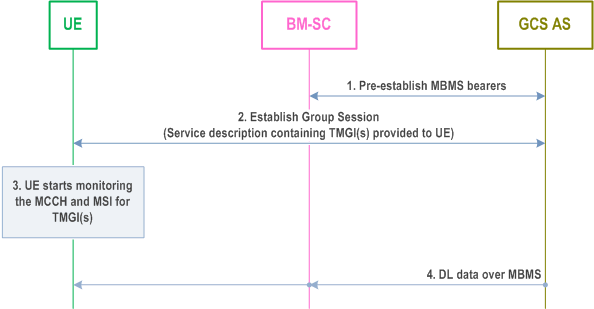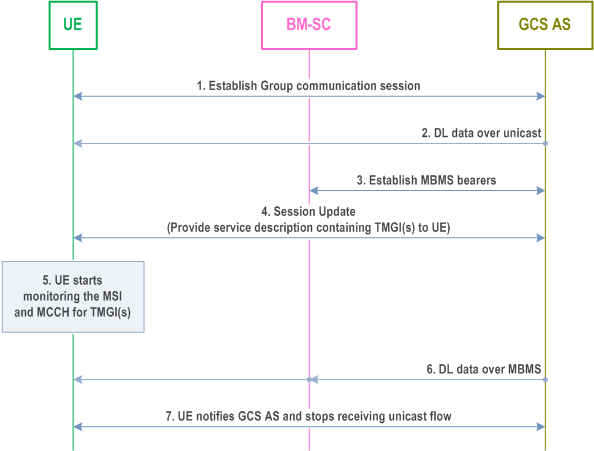Content for TS 23.468 Word version: 18.0.0
A Utilisation of the Group Communication Service
A.1 General
A.2 Downlink Media path setup for MBMS Delivery
A.2.1 General
A.2.2 Use of Pre-established MBMS bearers
A.2.3 Use of Dynamic MBMS bearer establishment
$ Change history
A Utilisation of the Group Communication Service p. 29
A.1 General p. 29
This Annex provides informative call flows for how a GCS AS can use the Unicast Delivery and MBMS Delivery mechanisms defined in this specification to deliver data to group(s) of users.
A.2 Downlink Media path setup for MBMS Delivery p. 29
A.2.1 General p. 29
This clause describes two procedures for establishing MBMS Delivery on the downlink:
- using pre-established MBMS bearers, or
- using dynamic establishment of MBMS bearers
A.2.2 Use of Pre-established MBMS bearers p. 29
In this scenario, the GCS AS pre-establishes MBMS bearer(s) in certain pre-configured areas before the start of the group communication session. When a UE originates a request for group communication for one of these areas, the pre-established MBMS bearer(s) is used for the DL traffic.

Step 1.
The GCS AS pre-establishes the MBMS bearers for the group communication session according to the procedures defined in clause 5.1.2.3.1. The BM-SC returns the MBMS service description associated with the MBMS bearer(s) to the GCS AS.
Step 2.
The UE establishes a group communication session with the GCS AS. The GCS AS passes the service description associated with the MBMS bearer service to the UE. The UE obtains the TMGI(s), identifying the MBMS bearer (s), from the service description.
Step 3.
The UE starts monitoring the MSI and MCCH of received MBSFN broadcast(s) for the TMGI(s).
Step 4.
Having detected a TMGI on MCCH the UE monitors the MSI and receives the DL data on the MTCH corresponding to the TMGI.
A.2.3 Use of Dynamic MBMS bearer establishment p. 30
In this scenario, the GCS AS uses a unicast bearer for communication with the UE on the DL at the start of the group communication session. When the GCS AS decides to use an MBMS bearer for the DL data, the GCS AS establishes one using the procedures defined in clause 5.1.2.3.1. The GCS AS provides the service description associated with MBMS bearer(s), obtained from the BM-SC, to the UE. The UE starts using the MBMS bearer(s) to receive DL data and stops using the unicast bearer for the DL data.

Step 1.
The UE establishes a group communication session with the GCS AS.
Step 2.
The downlink data is sent by Unicast Delivery.
Step 3.
The GCS AS establishes the MBMS bearer(s) for the group communication session according to the procedures defined in clause 5.1.2.3.1. The BM-SC returns the service description associated with the MBMS bearer(s) to the GCS AS.
Step 4.
The GCS AS provides the service description associated with the MBMS bearer(s) to the UE. The UE obtains the TMGI(s) from the service description.
Step 5.
The UE starts monitoring the MSI and MCCH of received MBSFN broadcast(s) for the TMGI(s).
Step 6.
Having detected a TMGI on MCCH the UE monitors the MSI and receives the DL data on the MTCH corresponding to the TMGI.
Step 7.
The UE notifies the GCS AS that it is receiving the data over MBMS for the given TMGI. The GCS AS stops sending DL data over unicast to the UE.